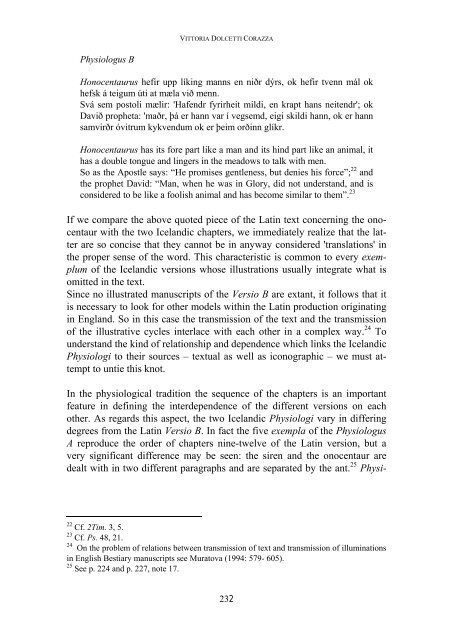Crossing paths in the Middle Ages: the Physiologus in Iceland - Lear
Crossing paths in the Middle Ages: the Physiologus in Iceland - Lear
Crossing paths in the Middle Ages: the Physiologus in Iceland - Lear
Create successful ePaper yourself
Turn your PDF publications into a flip-book with our unique Google optimized e-Paper software.
<strong>Physiologus</strong> B<br />
VITTORIA DOLCETTI CORAZZA<br />
Honocentaurus hefir upp lík<strong>in</strong>g manns en niðr dýrs, ok hefir tvenn mál ok<br />
hefsk á teigum úti at mæla við menn.<br />
Svá sem postoli mælir: 'Hafendr fyrirheit mildi, en krapt hans neitendr'; ok<br />
Davið propheta: 'maðr, þá er hann var í vegsemd, eigi skildi hann, ok er hann<br />
samvirðr óvitrum kykvendum ok er þeim orð<strong>in</strong>n glíkr.<br />
Honocentaurus has its fore part like a man and its h<strong>in</strong>d part like an animal, it<br />
has a double tongue and l<strong>in</strong>gers <strong>in</strong> <strong>the</strong> meadows to talk with men.<br />
So as <strong>the</strong> Apostle says: “He promises gentleness, but denies his force”; 22 and<br />
<strong>the</strong> prophet David: “Man, when he was <strong>in</strong> Glory, did not understand, and is<br />
considered to be like a foolish animal and has become similar to <strong>the</strong>m”. 23<br />
If we compare <strong>the</strong> above quoted piece of <strong>the</strong> Lat<strong>in</strong> text concern<strong>in</strong>g <strong>the</strong> onocentaur<br />
with <strong>the</strong> two <strong>Iceland</strong>ic chapters, we immediately realize that <strong>the</strong> latter<br />
are so concise that <strong>the</strong>y cannot be <strong>in</strong> anyway considered 'translations' <strong>in</strong><br />
<strong>the</strong> proper sense of <strong>the</strong> word. This characteristic is common to every exemplum<br />
of <strong>the</strong> <strong>Iceland</strong>ic versions whose illustrations usually <strong>in</strong>tegrate what is<br />
omitted <strong>in</strong> <strong>the</strong> text.<br />
S<strong>in</strong>ce no illustrated manuscripts of <strong>the</strong> Versio B are extant, it follows that it<br />
is necessary to look for o<strong>the</strong>r models with<strong>in</strong> <strong>the</strong> Lat<strong>in</strong> production orig<strong>in</strong>at<strong>in</strong>g<br />
<strong>in</strong> England. So <strong>in</strong> this case <strong>the</strong> transmission of <strong>the</strong> text and <strong>the</strong> transmission<br />
of <strong>the</strong> illustrative cycles <strong>in</strong>terlace with each o<strong>the</strong>r <strong>in</strong> a complex way. 24 To<br />
understand <strong>the</strong> k<strong>in</strong>d of relationship and dependence which l<strong>in</strong>ks <strong>the</strong> <strong>Iceland</strong>ic<br />
Physiologi to <strong>the</strong>ir sources – textual as well as iconographic – we must attempt<br />
to untie this knot.<br />
In <strong>the</strong> physiological tradition <strong>the</strong> sequence of <strong>the</strong> chapters is an important<br />
feature <strong>in</strong> def<strong>in</strong><strong>in</strong>g <strong>the</strong> <strong>in</strong>terdependence of <strong>the</strong> different versions on each<br />
o<strong>the</strong>r. As regards this aspect, <strong>the</strong> two <strong>Iceland</strong>ic Physiologi vary <strong>in</strong> differ<strong>in</strong>g<br />
degrees from <strong>the</strong> Lat<strong>in</strong> Versio B. In fact <strong>the</strong> five exempla of <strong>the</strong> <strong>Physiologus</strong><br />
A reproduce <strong>the</strong> order of chapters n<strong>in</strong>e-twelve of <strong>the</strong> Lat<strong>in</strong> version, but a<br />
very significant difference may be seen: <strong>the</strong> siren and <strong>the</strong> onocentaur are<br />
dealt with <strong>in</strong> two different paragraphs and are separated by <strong>the</strong> ant. 25 Physi-<br />
22 Cf. 2Tim. 3, 5.<br />
23 Cf. Ps. 48, 21.<br />
24 On <strong>the</strong> problem of relations between transmission of text and transmission of illum<strong>in</strong>ations<br />
<strong>in</strong> English Bestiary manuscripts see Muratova (1994: 579- 605).<br />
25 See p. 224 and p. 227, note 17.<br />
232

















